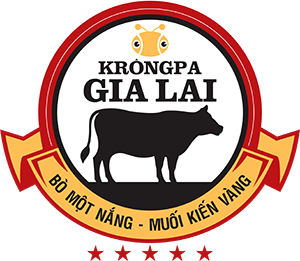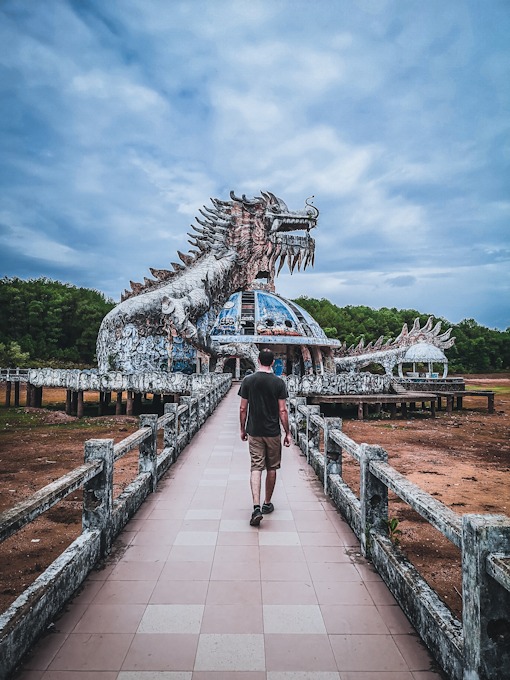Thông tin
99 Things to know before traveling in Vietnam
Vietnam has everything you expect on a trip to a new country: amazing natural creations including white sands, caves, mountains, architectural works, historic sites, ancient town and many hidden gems in alleys. The list of 99 Things to know before traveling in Vietnam will give you 99% necessary information for travelers about Vietnam. I hope you plan your trip better and enjoy Vietnam at its best.
Top tourist destinations and top tours in Vietnam
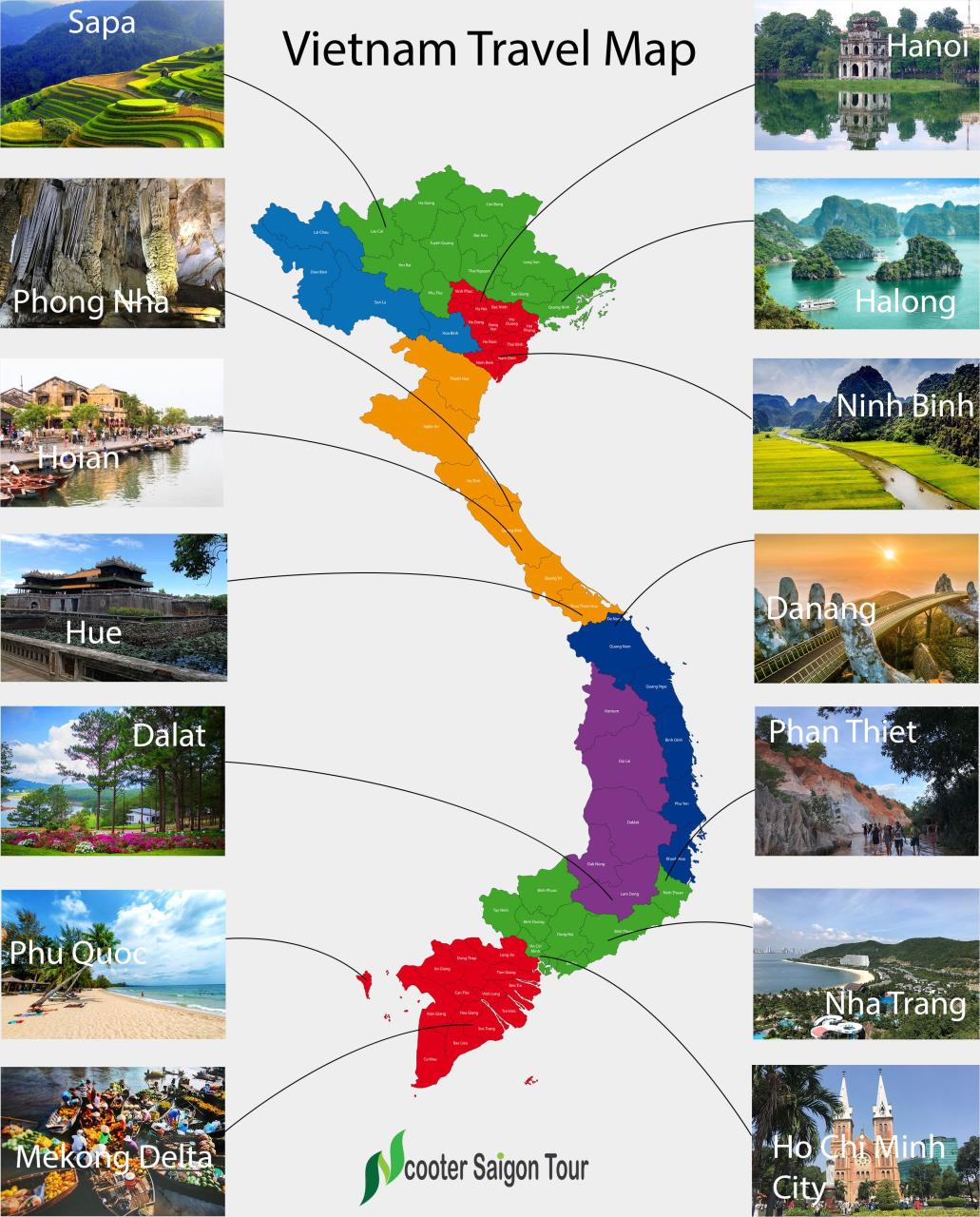
Vietnam Travel Map.
Northwestern
1. Sa Pa is the perfect land created by nature and humans. The town is cool around the year although it is cold in some months. The highlights of Sa Pa include step rice fields, local fare markets and mountain villages. Great specialty foods will definitely satisfy your taste. Book a 2-day Sapa Trekking Tour and Ethnic Minority Village Homestay which costs from $150 USD to enjoy the surprisingly beautiful mountains, step rice fields and learn about the unique local life of ethnic groups in Vietnam.
2. Ha Long Bay in Quang Ninh – one of the New Seven Wonders of Nature is a must-do in Vietnam, with thousands of towering limestone islands covered with rain forests and surrounded by emerald waters. The top activities include cruising to see surprisingly islands in shapes of chicken, teapot, dog, etc and visiting fishing villages. Staying overnight on a cruise ship in Halong is worth trying although prices are a little higher than staying in a hotel and cruising the bay during the day.
Sun World Ha Long Park is a 214-ha world-class amusement and recreational complex on Ba Deo Hill. You can sunbathe and swim at Bai Chay Beach.
You can book Full day Halong Bay Islands, Cave, Kayak, Swimming & Lunch Tour which costs from $40 USD; 2-day Halong Bay on Cruise which costs from $140 USD.
Red River Delta
3. Hanoi is the capital of Vietnam, the political, cultural and historical center of the country. This is one of the most crowded and busiest cities in Vietnam. There are hundreds of things to do in Hanoi, the top things to do include Sword Lake, Hanoi Old Quarter, Literature Temple, One Pillar Pagoda, Thang Long Citadel, Dong Xuan Market. Hanoi is also known as a street food paradise.
- Hanoi Sightseeing Tour costs from $25 USD.
- Hanoi Old Quarter and Street Food Tour costs from $25 USD.
4. Ninh Binh has attracted more and more tourists thanks to the wonderful beauty of Tam Coc – Bich Dong, Trang An Grottoes, Hoa Lu Temple, Bai Dinh Pagoda, Cuc Phuong National Park, Phat Diem Pagoda. A boat ride in Tam Coc on the river through mysterious caves and the countryside will be an unforgettable experience. Mountains, rivers, rice fields blend perfectly here. The Bai Dinh Temple Spiritual and Cultural Complex consisting of the old temple and a recently built larger temple and covering an area of 700 hectares is one of the impressive sites in the province.
- Hoa Lu – Tam Coc and Mua Cave: Boat & Biking & Hiking Tour costs from $50 USD.
North Central Coast
5. Quang Binh is the land of majestic caves in Phong Nha – Ke Bang National Park. The most famous caves are Paradise Cave, Phong Nh, Tien Son Caves which are known as heaven under earth. Son Doong Cave is the biggest cave in the world. A tour to Son Doong lasts 7 days 6 nights and costs about $3,000 USD. It is much cheaper to explore other caves. Any trip to Quang Binh can not be complete if the caves are missed.
- Full day Paradise Cave & Phong Nha Cave Tour costs from $70 USD.

Amazing creation in a shape of an ancient stupa in Paradise Cave in Quang Binh.
6. Hue is the citadel of Vietnam under the rule of the Nguyen Dynasty. This city is totally different from other provinces and cities in Vietnam. Everything looks peaceful, beautiful and quiet. The Citadel is a must-visit place in Hue, tombs of kings in beautiful large areas with mountains, rivers, lakes and the sacred Thien Mu Pagoda are worth seeing. Dong Ba Market is a good place to eat lots of amazing Hue foods.
- Full day Hue City Tour: Citadel, Royal Tombs & more costs from $32 USD.
Warmest Greetings To All from Tracy Do! If you have any questions about Vietnam, including Vietnam tours, do not hesitate to contact me.
- Tel (Call/SMS/Whatsapp): ( 84) 909190247
- Email: support@scootersaigontour.com
Tracy’s team is proud to provide excellent Vietnam tours and Vietnam travel services to thousands of guests for 10 years. Let us have a chance to show you Vietnam to the fullest.
North Central Coast
7. Da Nang has countless things to do, from beautiful beaches, Ba Na Hills, Marble Mountains, Son Tra Peninsula to Dragon Bridge, Linh Ung Pagoda, Golden Bridge.
- Full day Ba Na Hills & Golden Bridge Tour costs from $72 USD.
8. Quang Nam is famous with Hoi An Ancient Town where to see beautiful old houses built some hundreds of years ago, admire the beauty of colorful fabric lanterns at night and the lovely Thu Bon River. Thanh Ha Pottery Village, Tra Que Vegetable Village, My Son Sanctuary are the most popular tourist attractions in the province. You can explore the ancient town yourself. Other tours include:
- Half day Hoi An Bike Tour to the countryside Tour costs from $25 USD.
- Evening Food Walk Tour costs from $30 USD.
Central Highlands
9. Da Lat in Lam Dong has a large number of fantastic landscapes including Lang Biang Mountain, Love Valley, Tuyen Lam Lake, Datanla Falls, Cau Dat Tea Farm and religious sites such as Thien Vien Truc Lam, Cock Church.
- Dalat City Tour & Waterfalls costs from $50 USD.
- Dalat Canyoning Tour costs from $90 USD.
10. Nha Trang in Khanh Hoa has the most perfect beaches in Vietnam, with white and soft sand and clear water. Ponagar Towers, Stone Church, Husband Rock, 19 beautiful islands.
- Half-day Nha Trang City Tour costs from $25 USD.
- Snorkeling Tour at Hon Mun Island costs from $42 USD.
- Full day Shore Excursion in Nha Trang Bay costs from $100 USD.
Southeastern
11. Phan Thiet – Mui Ne in Binh Thuan is also famous for the nicest beaches, Red Sand Dunes, White Sand Dunes, Fairy Spring.
- Mui Ne Sunrise & Sand Dune Tour costs from $15 USD.
- Mui Ne Private Jeep Tour costs from $30 USD.
- Ta Cu Mountain Tour costs from $45 USD.
- Mui Ne to Vinh Hy Bay Snorkeling & Fishing Day Tour costs from $23 USD.
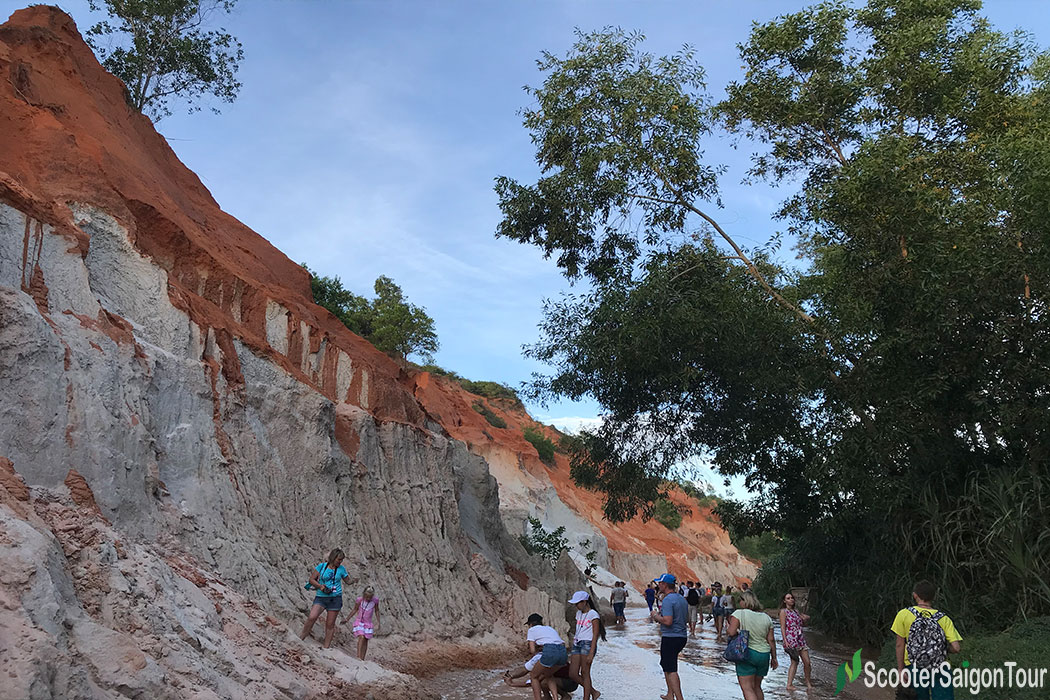
Spring Fall in Phan Thiet, Ninh Thuan.
12. Ho Chi Minh City is the biggest and most crowded city in Vietnam. Besides French architectural works such as City Hall, Notre Dame Cathedral, Saigon Central Post Office, Independence Palace, the city has lots of pagodas including Ngoc Hoang Pagoda which President Barrack Obama visited. Ben Thanh Market is a good place to go shopping and eat street foods. Cu Chi Tunnels – Viet Cong soldiers’s base which impresses visitors by the 250-km-long underground tunnels.
- Half day Ho Chi Minh City Tour costs from $10 USD.
- Ho Chi Minh City Street Food Tour costs from $40 USD. Learn more…
- Half day Cu Chi Tunnels Tour costs from $10 USD.
Mekong Delta
13. Mekong Delta is a perfect place to relax and escape the noisy and crowded Ho Chi Minh City. The Nine Dragon Region is a peaceful land where tourist see rice fields, lush orchards, lines of coconut trees, local markets with fresh fruits and live animals. The highlights of this region include the complex system of rivers and channels, islands, unique floating markets. Staying at homestays in the region is worth doing. The most popular activities include cruising waterways by boats and sampans with local riders, riding bicycles on dirt roads through the quiet villages, trying catching fishes. Specialty foods made from fresh vegetables and freshwater fishes, honey tea, fresh seasonal fruits, peanut and coconut candies are great foods to taste in the regions. You should not miss traditional trade villages where they earn living by making candies, brooms, mats, clear rice noodles, bricks, nipa palm leaf roof sheets, etc. Farms are to see pythons, porcupines, crocodiles, fishes, bees and other animals should not be missed on a tour to Mekong Delta. Phu Quoc Island has the top beaches in Vietnam and the world.
- Ben Tre: kingdom of coconut, Phoenix, Unicorn, Turtle, Dragon Islets.
- Vinh Long: fruit orchards.
- Tien Giang: Cai Be Floating Market, Vinh Trang Pagoda, Dong Hoa Hiep Ancient Village, Dong Tam Snake Farm.
- Can Tho: Cai Rang Floating Market, Phong Dien Floating.
- Soc Trang: Nga Nam Floating Market, lots of Khmer pagodas, Clay Pagoda.
- Dong Thap: Huynh Thuy Le Ancient House, Kien An Cung, Sa Dec Flower Village, Xeo Quyt Relic Area, Tram Chim National Park.
- An Giang – Chau Doc: Tra Su Cajuput Forest, Sam Mountain.
- Kien Giang – Phu Quoc: Sao Beach, Khem Beach, Long Beaches, Painting Spring.
Popular tours to Mekong Delta from Ho Chi Minh City:
- Full-day Mekong Delta Tour (My Tho – Ben Tre/Cai Be Floating Market/Ben Tre/Go Cong).
- 2 days Mekong Delta Tour to Cai Rang Floating Market.

14. Two weeks are not enough to experience entire Vietnam but it is enough to see the most impressive things in various regions of the country.
Vietnam weather
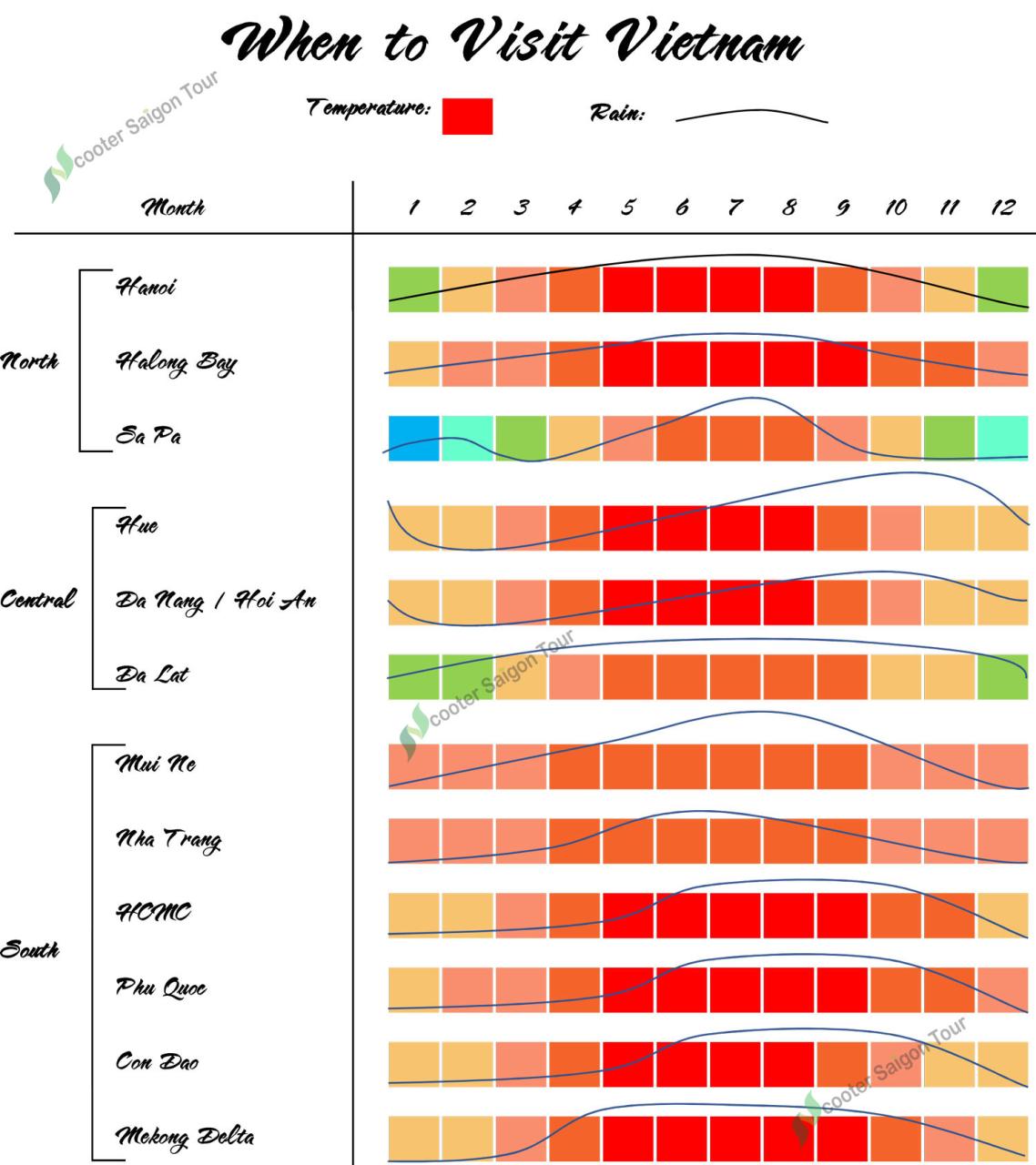
Vietnam weather chart – temperature and rain.
15. The climate is dramatically different in various regions of the country.
In the North (Hanoi, Sapa, Halong, Ninh Binh), it is the coldest from December to January, sometimes it snows, temperature ranges between 20 to 30°C. From May to October, it is hot and usually rains in the evening. It is cool but a little dry, the temperature is from 15 to 25°C.
In the Central (Hoi An, Da Nang, Hue), it is very hot and dry from November to October, the average temperature is 35°C. It rains from September to November. In North Central, it still rains until January. It rains heavily in October and November.
In Nha Trang, the dry season lasts from January to September, the average temperature in this season is 26°C. It rains from October to December.
In South Vietnam (Ho Chi Minh City, Mekong Delta), the average temperature is 25°C. The dry season is from November to May, it is the hottest from February to April. It rains from May to November, it rains heavily from June to August, it usually rains in the afternoon.

Tourists and guides wear convenient raincoats when it rains slightly.
16. Vietnam is hot and humid, you will sweat despite continuous rains. It is only cold in the North and it is always hot in the South.
Best time to visit Vietnam
17. What is the best time to visit Vietnam? Tourists can visit Vietnam at any time of the year. From October to December, it rains heavily in most provinces. From December to January, it is the coldest in the North. It is recommended to travel to Vietnam from February to April and August to September.
Vietnam packing list
18. You should consider packing thick raincoats, umbrellas, thick books, many electronic devices, fabric masks, large toiletry bags, makeup bags, expensive jewelry, oversized and thick towels, all denim outfits, many winter clothes, knee high boots, foods and drinks for your trip to Vietnam. They may take up much space in your suitcase and make the suitcase heavier.
19. Packing one outfit for each day is not necessary because laundry services are cheap, fast quick and abundant in big cities, tourist hotspots and areas near tourist attractions Vietnam.
20. Hair dryers and flip flops are provided at most of the hotels in Vietnam. Ask the staff if you can not find them in your room.
Read more about 10 Things You Should Never Pack for a Trip to Vietnam
21. Insect repellent is a must thing to pack in Vietnam where mosquitos and other insects are everywhere. They may appear in your hotel rooms, on the streets and are abundant in forests and the countryside.
22. Power adapters and portable chargers should be packed because you may not find suitable power sockets when you are in Vietnam.
23. An earplug is an essential thing to pack for Vietnam because no one is sure that it is quiet in his hotel room. The noise caused by the crowds, vehicles on the streets, neighboring restaurants, bars or houses, construction sites may affect the quality of your sleep and ruin your trip.
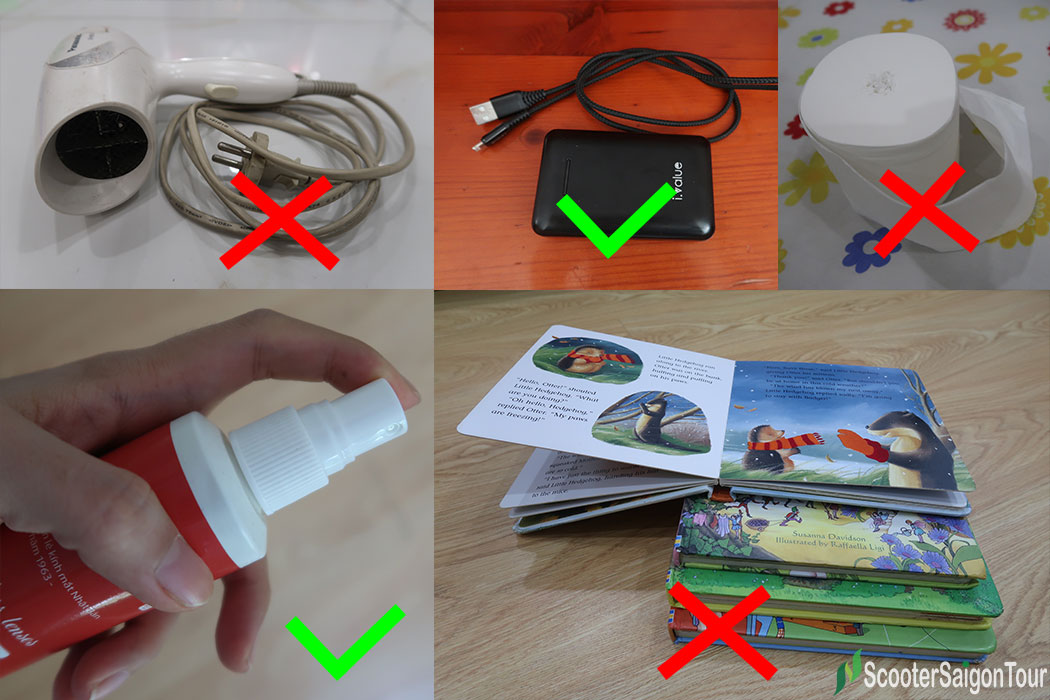
What to pack and what to leave at home?
Read more about Top 10 Essential Things to Pack for Vietnam Trip
Foods
24. Banh mi (Vietnamese sandwich, Bánh mì) is the most portable, cheap and amazingly delicious.
25. A bowl of piping hot Pho (Phở), topped with beef and served with vegetables and herbs is a safe, healthy and unique food in Vietnam.
26. Other must-eat Vietnamese foods include spring roll (Gỏi cuốn), Kebab rice noodle (Bún chả), Hue beef noodle soup (Bún bò Huế), Crab noodle soup (Bánh canh cua), Grilled beef in wild betel (Bò lá lốt), Vietnamese pancake (Bánh xèo), Hue cakes (Bánh Huế), Cao lau (Cao lầu), Quang noodles (Mì Quảng) are the must-try foods in Vietnam.
27. Foods fear factor and weird foods such as blood soup, rats, snakes are not safe but Fertilized duck egg (Balut) is safe to eat.
28. Choose live seafood (lobsters, crabs, ocean crabs, scallops, clams, oysters, fishes) at seafood restaurants in order to make sure your dishes are made from fresh ingredients and avoid digestive disorders.
29. Never eat at an empty restaurant which may sell expensive but poor-quality foods.
30. Do not eat at a restaurant or street food stall where they do not wear gloves when serving foods.
31. Observe how they wash the dishes and if they serve you with foods on dry dishes. It is not safe to eat at eateries where they wash dishes without dishwashing liquid or in one change of water.
32. Clean your utensils with paper napkins and lime wedges that are available on dining tables.
33. Street foods are cheap and help to maximize your budget. If you choose the right restaurants, it is a good chance to enjoy uniquely delicious street foods.
The ultimate guide to food safety in Vietnam
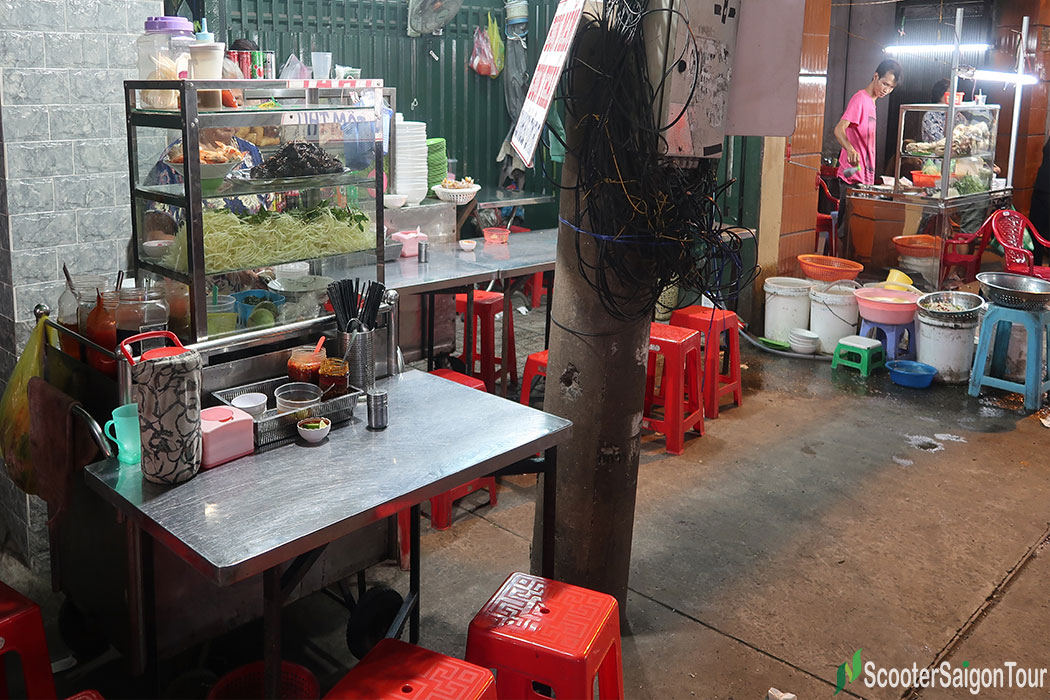
Street food stalls in C200 Alley, District 4, Ho Chi Minh City.
Drinks
34. Never drink tap water in Vietnam because it is contaminated with pathogenic organisms and a major source of sickness. Read more… A 500-ml bottle of water costs about VND 5,000 in Vietnam.
35. Vietnamese coffee is strong but a must-try drink. Find coffee brewed with Phin filters or fabric filters (stocks). Egg coffee and coconut coffee are distinct drinks to sample in Vietnam.
36. Vietnamese coffee made from poor materials (batteries, corns, beans, dangerous toxic chemicals) is popular in Vietnam. It is not worth the risk of drinking cheap coffee on the street.
37. Drinks made from toxic chemicals are sold popularly at drink stalls on the streets.
38. Never buy coconut fruits that have been cut at the top and the coir (middle, fibrous coat) are in white color. They may be soaked in Javen liquid in order to keep the coir from turning black or brown all day.
39. Order a canned or bottled drink instead of juices, mixed drinks if you are not sure about the safety at a restaurant (or street food stall, coffee shop, drink stall).
40. Ice cubes in your drinks in Vietnam is not always safe to digest. A cool can or bottle of soft drink, a cool coconut fruit is better than a glass of iced soft drink. A hot cup of tea is perhaps safer than a glass of iced tea.
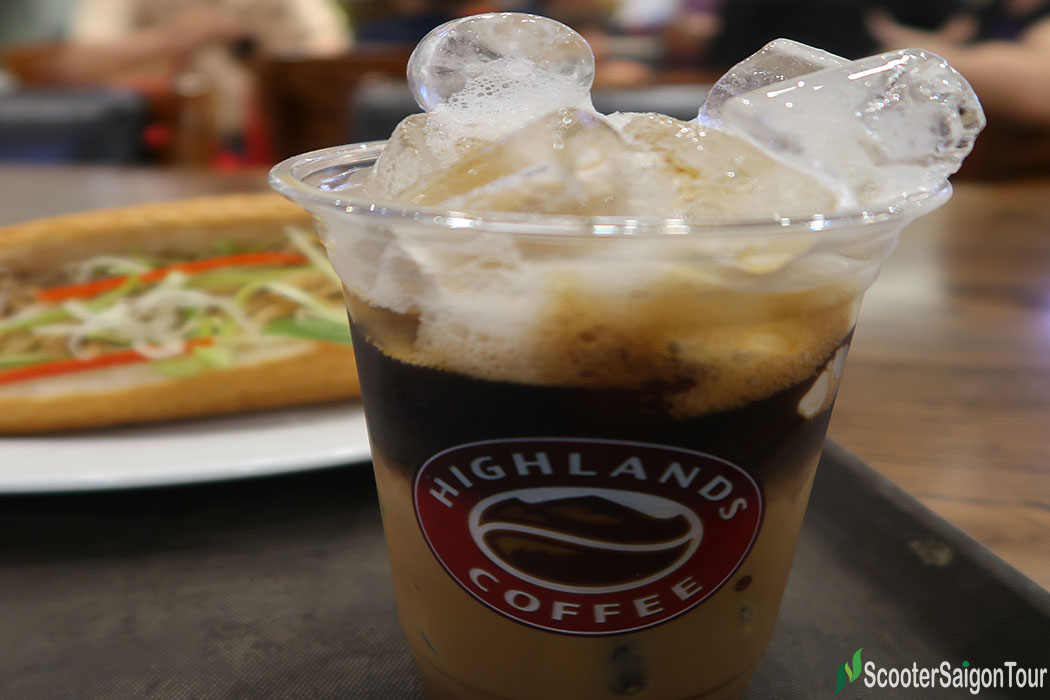
Vietnamese coffee with condensed milk is strong but it is a must-try in Vietnam. Cubes are not always safe to drink in Vietnam so that choose coffee shops selling safe iced coffee.
Avoiding getting sick
41. Hand sanitizer is a must belonging because not all restaurants (local markets) have restrooms, not all restrooms are clean and provide soap (or liquid hand wash).
42. Facial tissues, toilet paper and paper napkins should be in your bag when you go out in Vietnam. Sometimes, toilet paper is not provided or runs out in restrooms, or toilet paper and paper napkins are low quality.
43. Stay away from stray animals that are not cute and mild. They may hurt you or spread infections to humans. Stray dogs in Vietnam may carry rabies, a dog bite will ruin your trip.
44. Do not brush your teeth with tap water which is not safe to digest if you stay in Vietnam for a short time. Read more…
45. The air quality is especially poor in some big cities such as Hanoi and Ho Chi Minh City on some special days. The air is polluted in the centers of the cities in rush hours. So that you should wear masks when walking or riding a motorcycle from 6:00 AM to 8:00 AM, and 4:00 PM to 7:00 PM on weekdays in big cities.
46. The sun can be very strong from 11:00 AM to 2:30 PM in Vietnam. Wear a hats and a jacket, avoid going under the strong sun right after exiting from an air-conditioned building, drink water regularly and eat soup-like foods which are good sodium sources.
47. At government-owned hospitals which are usually crowded with patients, they do not speak English. You should go to international hospitals where staff and doctors are experienced on taking care of foreign patients. Learn about 50 Medical Clinics and International Hospitals in Vietnam.
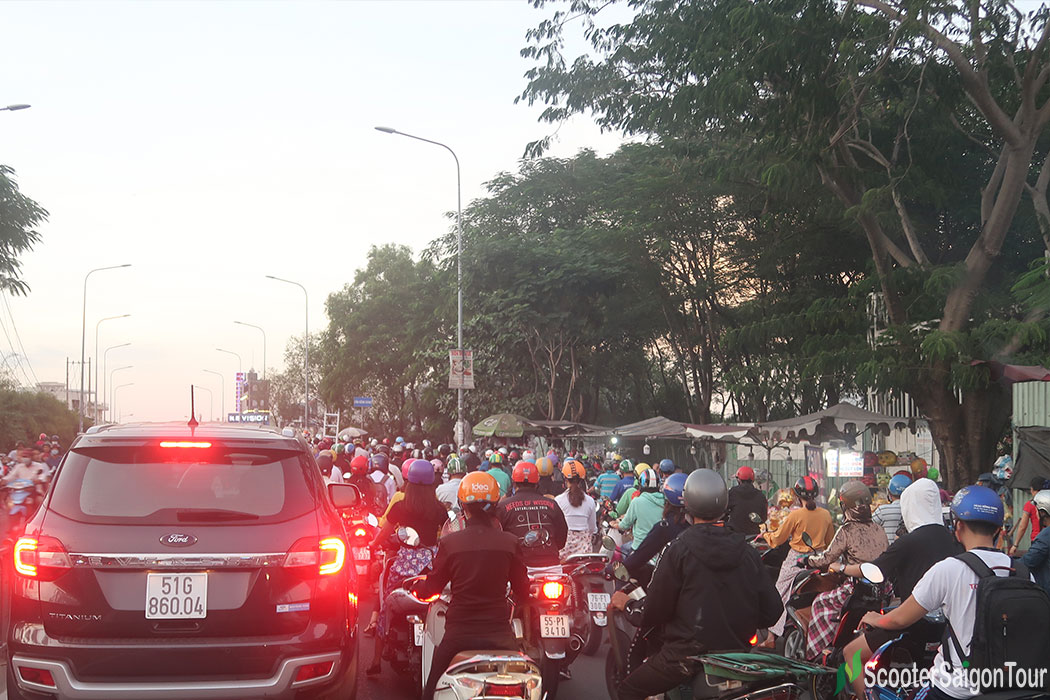
Rush hours in Vietnam.
Things to know before booking hotels in Vietnam
48. OTAs offer hotel rooms at more attractive prices and free cancellation. We can also browse lists of accommodations, search by region, filter by prices, read reviews on the websites or apps of Agoda.com, Booking.com, Expedia.com, Hotels.com, Trivago.com.
49. Booking an AirBnb is a good way to save money if there are more than three people in your group. An apartment with two or three bedrooms on AirBnb is cheaper than a hotel family room or two separate hotel rooms.
50. A Vietnamese citizen is not allowed to stay in the same hotel room with a foreigner in Vietnam. Although some hotels allow you to share your room with your Vietnamese partner, others ask you to book another room for the Vietnamese partner.
51. Do not give you your passport to the staff at your hotel. Give them a copy of the passport.
52. It is not really safe to keep so much money or expensive jewelry in the safety box at your hotel in Vietnam. It is recommended to pay for hotels and tours online. Do not bring so much money but pay by credit cards or withdraw money from ATMs.
53. There may be no barrier between the toilet area and the bathing area in some bathrooms. The floor in such a bathroom is regularly wet and dangerous for the elderly and children. Wear flip flops before entering a bathroom without barrier.
54. Hard mattresses are usually furnished in accommodations in Vietnam because Vietnamese people are familiar to sleeping on hard surfaces such as sedge mats on wooden beds. Some hotels provide soft mattresses in order to meet the expectations of Western and American tourists. Read reviews about mattresses at hotels if you can not sleep well on hard ones.
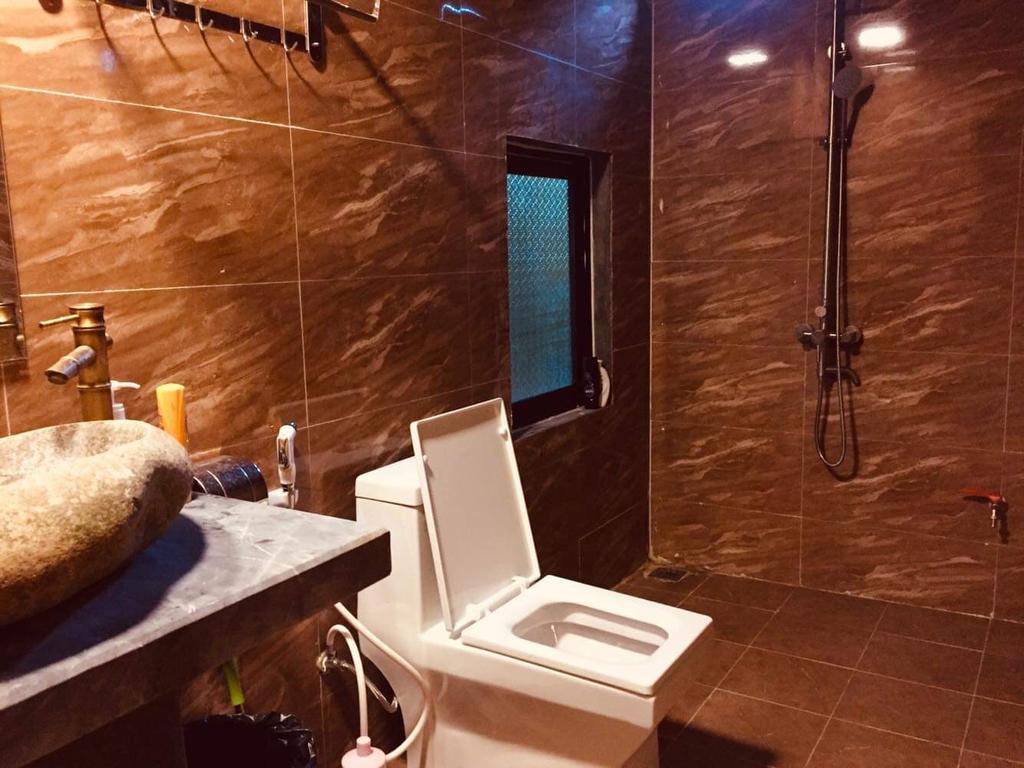
There is no barrier between the toilet area and the bathing area.
Rules and laws in Vietnam
55. Three adults on a motorcycle are prohibited. Two adults and one child at age under 14 on a motorcycle is legal.
56. Never drive after drinking alcoholic beverages. You will be punished if you have any certain breath/blood alcohol concentration. Read more…
57. Say no to sexy workers on the streets because prostitution is prohibited in Vietnam.
58. If you bring pornography in your luggage, you may get caught.
59. Do not stand or sit in a crowd if you do not know exactly what they are doing. You may get caught if they are protesting. Protests and activities causing social disorders are not illegal in Vietnam.
10 illegal things in Vietnam – Rules and laws for tourists and expats
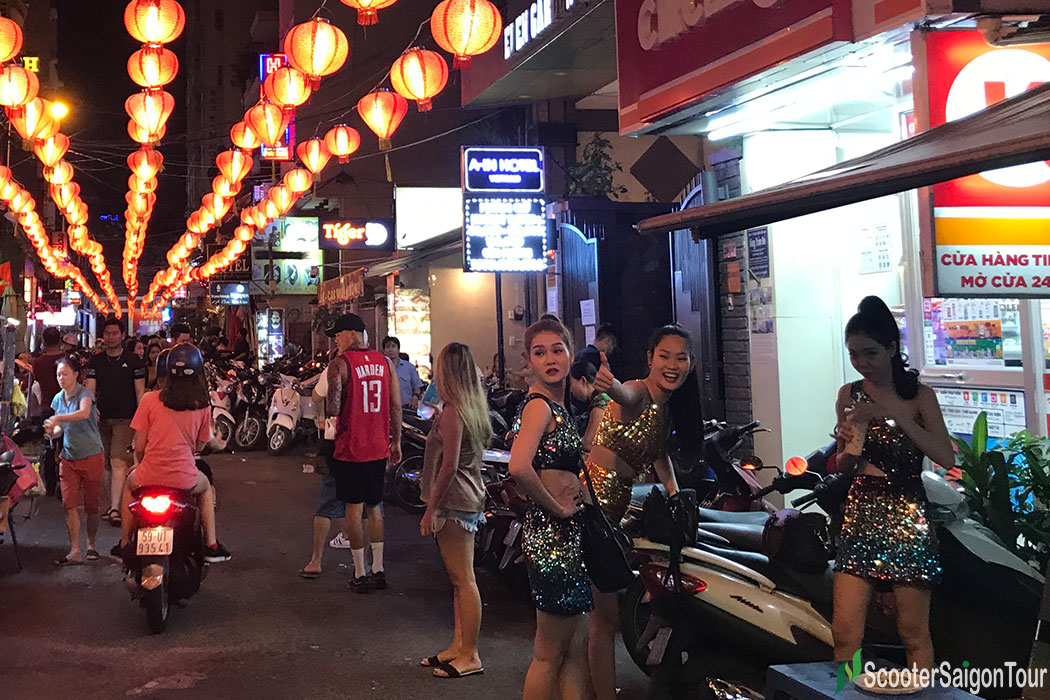
Prostitution is prohibited in Vietnam.
Transportation and traffic
60. In Vietnam, the traffic is crazy as you may have heard read about. Lines on roads sometimes mean nothing because motorcycle drivers can drive on any lane of the streets. However, you will be familiar with that after one or a few days.
61. In rush hours, you must wait for hours on the streets in centers of big cities such as Ho Chi Minh City and Hanoi.
62. Motorcycle is the most popular and effective means of transportation in Vietnam. Do not be afraid of sitting on the back or a motorbike weaving through small alleys and the main roads. Hidden gems of Saigon and Hanoi are located in “ngõ”, “ngách”, “hẻm” which can be called alley in English. City tours by motorcycle are off-the-beaten-path things to do in Vietnam.
63. A cyclo driver who looks kind suddenly appears and offers you a short ride around the city at a good price. You may agree with him and hop on the vehicle. He may drive you to a lonely place, ask you to pay him VND 500,000 (~24 USD) or he will leave you there or even steal valuable things from you. If you would like to ride a cyclo, book the ride with a trusted tour agency.
64. A motorcycle taxi driver may agree to drive you to a destination at the price of VND 50,000. Upon arrival, he may ask you to pay VND 500,000. He may tell you that you misunderstood, the cost of the ride is not VND 50,000 but VND 500,000.
65. Most of the coaches are good and comfortable to sit in, with the exception of holidays. Some public city buses are not in good condition, they are usually packed with passengers in rush hours.
66. Trains in Vietnam are older and slower in comparison to trains in many developed countries. The train ride is bumpy so that you may get tired after long rides. Prices of the most expensive train ticket class (soft sleeper and air-conditioned bed cabin) are not higher than flight tickets which are faster and more comfortable.
67. The prices of Jetstar and Vietjet flights are cheaper than Vietnam Airlines flights’ prices and save a lot of money on your trip to Vietnam. However, Jetstar and Vietjet flights are often canceled and delayed.
68. Crossing the street is easier than you thought. The first rule is finding a designated crosswalk or painted lines on the streets that indicate that pedestrians are safe there. Remember that most Vietnamese drivers do not stop and wait until pedestrians finish crossing the streets.
69. Scam taxis are popular in Vietnam. Taximeters may not be reliable, drivers may drive through unnecessary streets in order to earn more money. Mai Linh, Vinasun, Saigontourist are trusted taxi company. However, there are also fake Mai Linh and Vinasun taxis.
70. Uber is not available in Vietnam. You should install Grab App if you would like to book a car or motorcycle ride.
71. International driven licenses are valid if you are a traveler having a tourist visa, being valid for less than 3 months. If you have an IAA (International Automobile Association) or IDP (International Driving Permit) issued by one of the countries listed in Vienna Convention on Road Traffic, you can drive in Vietnam. Remember to bring both the international driven license and domestic driven license. Read more…
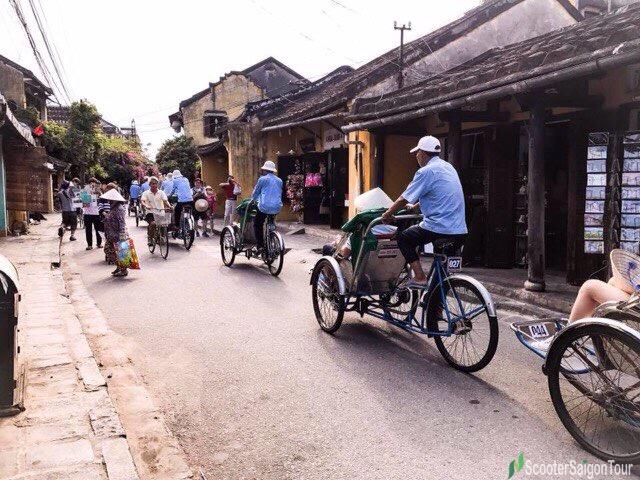
Booking cyclo rides or cyclo tours with trusted companies instead of dealing with taxi riders on the streets.
Electricity
72. In Vietnam, the standard voltage is 220 Volt and the frequency is 50 Hertz. Check if your device works with the standard voltage and frequency in Vietnam.
73. Plugs type A, C, F fit to most of the power sockets in the country. Sometimes, you can find electrical outlets supporting plugs type B, D, E, G. Read more…
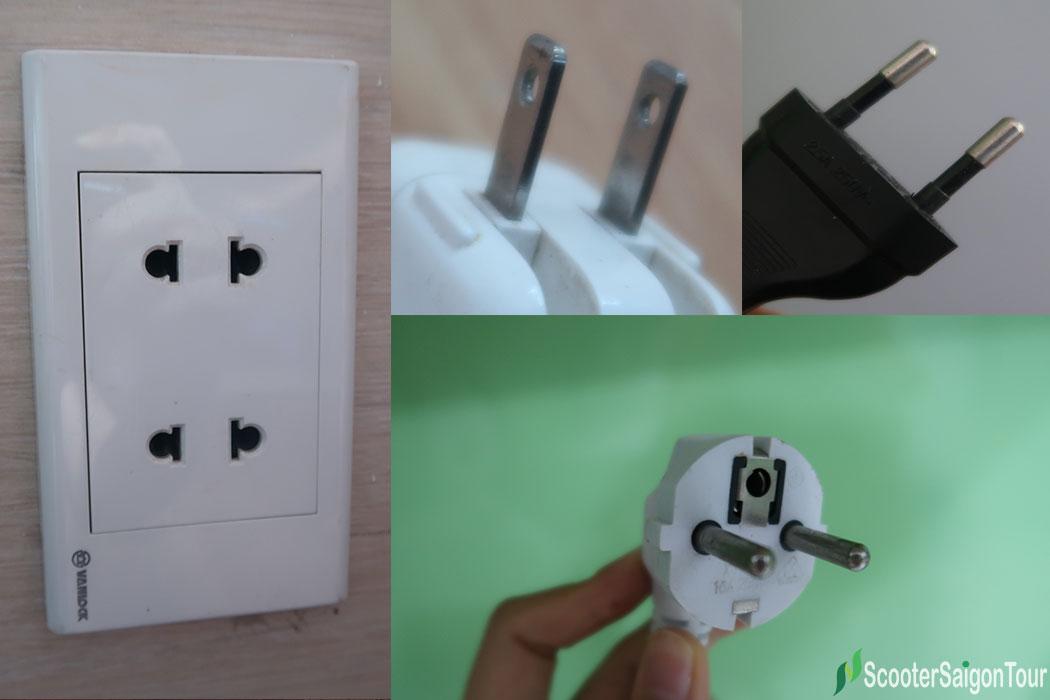
The most popular electrical socket in Vietnam and plugs type A, C, F which fit to most of the power sockets.
Vietnamese currency
74. All people in Vietnam is a billionaire. The minimum wages range between VND 3,070,000 and 4,420,000. Banh mi – one of the cheapest food for breakfast in Vietnam costs from VND 10,000. 200 and 500 banknotes are rarely seen in Vietnam.
75. 200,000 Dong and 10,000 Dong banknotes look similar, some vendors do not let you know that you gave them the wrong banknote.
76. The exchange rates at gold shops or some money exchange spots in backpacker areas are higher than at airports, tourist attractions, banks, tour desks and hotel receptionists.

200,000 Dong and 10,000 Dong banknotes.
Budget
77. It is very cheap to travel to the S-shaped country if you stick to cheap hotels, guest houses, homestays, AirBnb, dorms, street foods, public transportation or motorcycle. Buying an old motorcycle and ride it on your trip to Vietnam is a good way to explore the country to its fullest and maximize your budget. You must spend too much money in expensive countries such as Dubai, Switzerland, Norway, Japan, Denmark, and many others. Traveling to Vietnam can be as expensive or cheap as you want to be.
78. The rough prices of basic costs are as follows:
- Transport:
- Domestic flights: $36 – 45 USD (Vietjet and Jetstar offer better prices than Vietnam Airlines).
- Bus or train tickets between provinces and cities: $5 – 30 USD. For example, a ticket for a bus from Hanoi to Ho Chi Minh City costs $30 USD, traveling from Hanoi to Ninh Binh costs only $6 USD.
- Buying motorcycle: from $256 USD.
- Accommodation: a dorm costs $5 – 8 USD, a private room costs $18-25 USD.
- Foods: a meal at a street food stall costs $1 – 2 USD, a meal at a local restaurant cost $3 – 6 USD, a meal costs from $10 USD at a higher end restaurant.
- Drinks: a cup of coffee at a shop costs from $1 USD, a bottle of beer at convenience stores, supermarkets, street food stall and reasonably priced restaurants costs $0.75 – 1.5 USD.
79. Good news for you, the admission fees at museums, Independence Palace are only $2 USD, you do not need to pay to visit some beautiful architectural works such as Saigon Central Post Office, churches, pagodas, temples, markets in Vietnam. The entrance fees at the top popular tourist attractions are as follows:
- Cu Chi Tunnels: $6 USD;
- Nguyen Kings’ tombs: $7 USD;
- The Citadel in Hue: $17 USD;
- Halong Bay: $15 USD;
- Paradise Cave: $12 USD; Electric car (2 ways): $4.5 USD;
- Phong Nha Cave: $7 USD; Tien Son Cave: $3.5 USD; Boat (12 people): $17 USD;
- Ba Na Hill cable car: $35 USD.
- Hoi An Ancient Town: $5 USD; Thanh Ha Pottery Village: $0.75 USD.
Stay safe in Vietnam
80. Go drinking with at least one partner, never drink too much, stay away from any argue at bars, pubs and places where they drink beers and other alcoholic drinks in the country.
81. Vietnam is safe but it is recommended not to go out after midnight in big cities and after 9:30 PM in the countryside, less crowded provinces and cities, non-urban areas.
Snatch thief and pickpocket
82. Snatch thieves and pickpockets are popular in Vietnam, they are on public buses, at airports, bus stations, railway stations, parks, markets, shopping centers. Be careful with your belongings when you are surrounded by lots of people. Especially, some of the thieves and pickpockets “works” only in tourism hotspots, around tourist attractions, backpacker areas because they may steal some dollars and expensive things including smartphones, cameras and jewelry. Never put your passport in your backpack when you go out in Vietnam. Make some copies of the passport, bring one copy with you and leave the original passport at your hotel. Expensive jewelry should be left at home. They may make you fall when they try to steal your necklace or bracelet. A cellphone security ring or a security camera strap will be helpful.
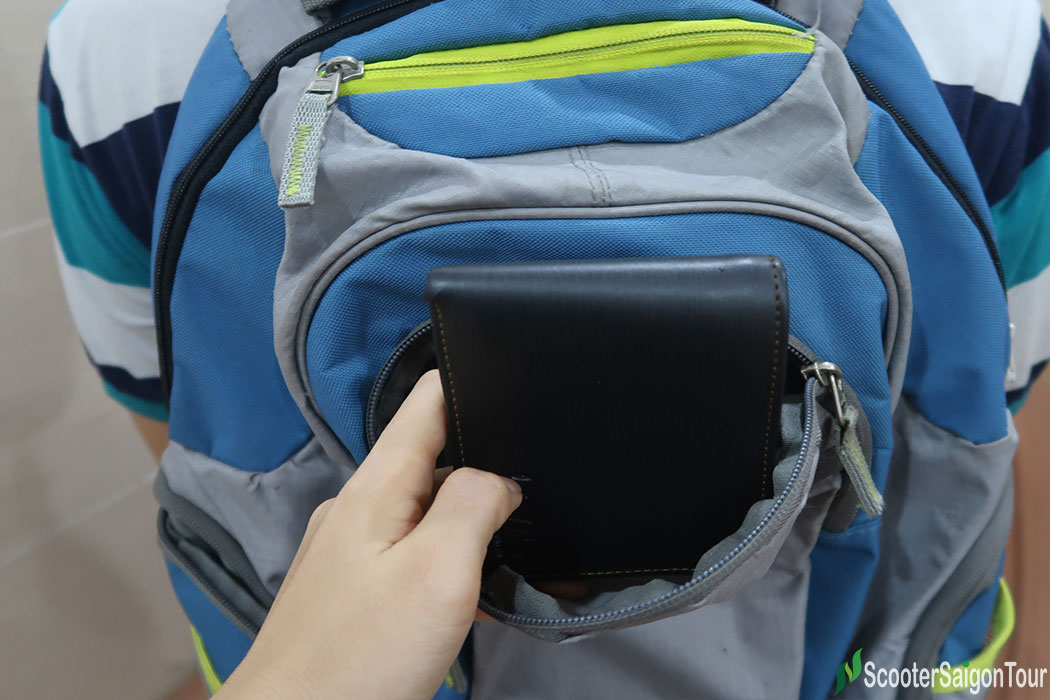
Never put your wallet into outer compartments of backpacks or bags in Vietnam.
TripAdvisor review
83. Not all reviews on TripAdvisor – the world’s largest travel community are reliable. Some hotels, restaurants and tour companies find many ways to hunt for 5-star reviews. They reward the staff by the number of positive reviews on TripAdvisor. They tell friends and partners to post reviews written by themselves. How to recognize fake reviews? Discarding one-time review although some one-time review is real. Browse the TripAdvisor user and view his profile. If a negative review posted by a user who has left many negative reviews about other properties on the website, you know that he may be hard to please.

One-time review on TripAdvisor is not reliable.
Visa
84. Visa regulations in Vietnam keep changing so that you should double-check before your trip to Vietnam. Until the end of 2019, visa-free for 30 days is granted to citizens of Singapore, Indonesia, Malaysia, Thailand, Cambodia, Laos; visa-free for 21 days is granted for Philippine; visa-free for 14 days is granted to citizens of Brunei and Myanmar; visa-free for 15 days is granted to citizens of Spain, Italy, Germany, France, UK, Finland, Norway, Sweden, Russia, Denmark, South Korea, Japan.
85. A free visa on arrival is non-extendable so that you should apply for a tourist visa if you plan to stay in Vietnam for a longer period of time.
Holiday
86. Tet is the biggest festival in Vietnam and someone believes that it is also a great time to see Vietnam at its most beautiful and learn about the Vietnamese culture. From 27th December in the lunar calendar, big cities are less and less crowded. From 1st January, big cities are deserted but pagodas are crowded.
Prices of hotels and services will be about twice higher and the quality of services is worse than at another time of the year because many Vietnamese people do not work at Tet festival and some tourist attractions which are the favorite of Vietnamese people and Chinese people are very crowded. Prices of tickets for domestic flights, trains and buses are also higher because a large number of people go to their hometowns in other provinces and cities to enjoy Tet with their families.
From 27th December in the lunar calendar, big cities are less and less crowded. From 1st January, big cities are deserted but pagodas are crowded. Restaurants, coffee shops, some local markets are closed for a period of 1 – 10 days.
If you really would like to come to Vietnam and learn about the Vietnamese New Year, you should plan the trip to end before 1st January in the lunar calendar. One week before Tet, tourists can see colorful streets decorated with lights and flowers, go to Tet flower markets, spring flower festivals, taste some foods for Tet. Celebrating the Vietnamese Lunar New Year’s Eve is also a good idea although top places to view firecrackers are packed with people.
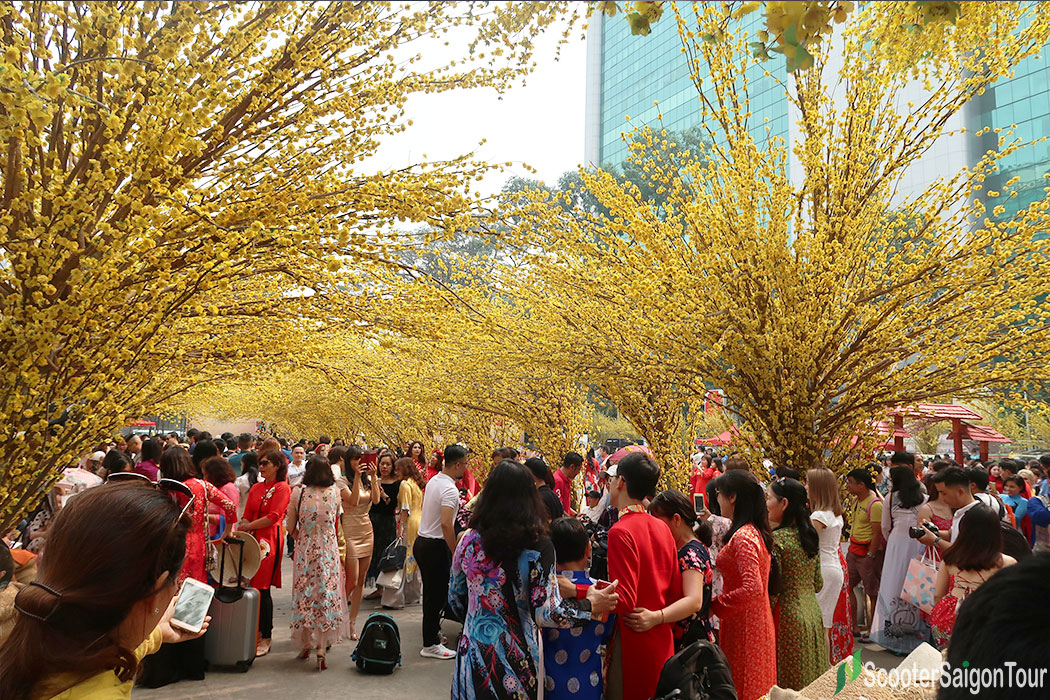
It is crowded at Tet festival in Vietnam.
87. On public holidays such as New Year’s Day on 1st January, Hung Kings Commemorations on 10th of the lunar 3rd month, Day of Southern Liberation for the National Reunification on 30th April, International Labour Day on 1st May, National Day on 2nd September, workers in Vietnam can be off for 1-4 day holiday. If the holidays last longer, they usually return to their hometowns or travel to other provinces, prices of tourism products are higher and tourist attractions are packed with thousands of people. If workers get only 1 day off, they go to shopping centers and tourist attractions in the same cities.
Read more about Pros and cons of visiting Vietnam at Tet Festival
Wifi
88. Wifi is relatively good in big cities, it may be weak on mountains, in forests and in the countryside. Free wifi is available and rather good at airports, hotels, restaurants and coffee shops. At shopping centers and hospitals, they provide free Wifi but the Wifi signal is weak, based on my experience. Sometimes, the Wifi signal is good on the upper floor but weak on your floor. Read reviews about Wifi at the accommodations you would like to book if you often surf the Internet at hotel rooms.
Simcard
89. Simcards and mobile data plans (3G/4G) are not expensive in Vietnam so that they are recommended to buy. At Simcard stalls at airports, prices are higher than at official stores of telecommunication providers and Simcard stores in cities’ centers. The top providers in Vietnam include Viettel, Mobifon and Vinaphone. Showing them your passport, they will sell you a Simcard for tourists. For example, the Viettel Tourist Simcard plus VND 70,000 for 7 days costs $4.5 USD, the Viettel Tourist Simcard plus VND 160,000 for 15 days costs $8.5 USD. You can buy top up credits which cost from $2.5 USD. When you add top up credits, you get additional validity days. The rates are as follows:
- Domestic call: $1 USD;
- Internation call via IDD/VoIP 178: $1.5 USD;
- Domestic SMS: $0.25 USD;
- International SMS: $1 USD;
You can choose from Tourist Voice (call, SMS, 3G/4G) or Tourist Data (3G/4G). Prices of Tourist Simcards and rates keep changing so that you should ask them when you buy a Simcard and top up credits.
Shopping
90. Vietnam is a paradise for shopaholics who would like to buy cheap but high-quality clothing, accessories, souvenirs and specialty foods.
International brand clothing and accessories are sold at large modern shopping centers but there are not many promotion programs. Some shopping centers such as Saigon Square, An Dong Plaza and markets Ben Thanh Market, An Dong Market sell good clothing items, shoes, scarfs, hats, jewelry, etc. If you are good at bargaining, you can buy a large number of high-quality items at cheap prices.
Souvenirs are sold popularly in Vietnam and prices are not very expensive. I would like to recommend to buy conical hats, sand, embroidered, lacquered or rice paintings, handicrafts. Dried squids, fishes, earthworms, fruits and vegetables, coffee, teas, seeds and nuts are worth buying in Vietnam. These things are available at stores in and around tourist attractions, tourist hotspots, markets such as Dong Xuan, Ben Thanh, Dong Ba, Han, etc.
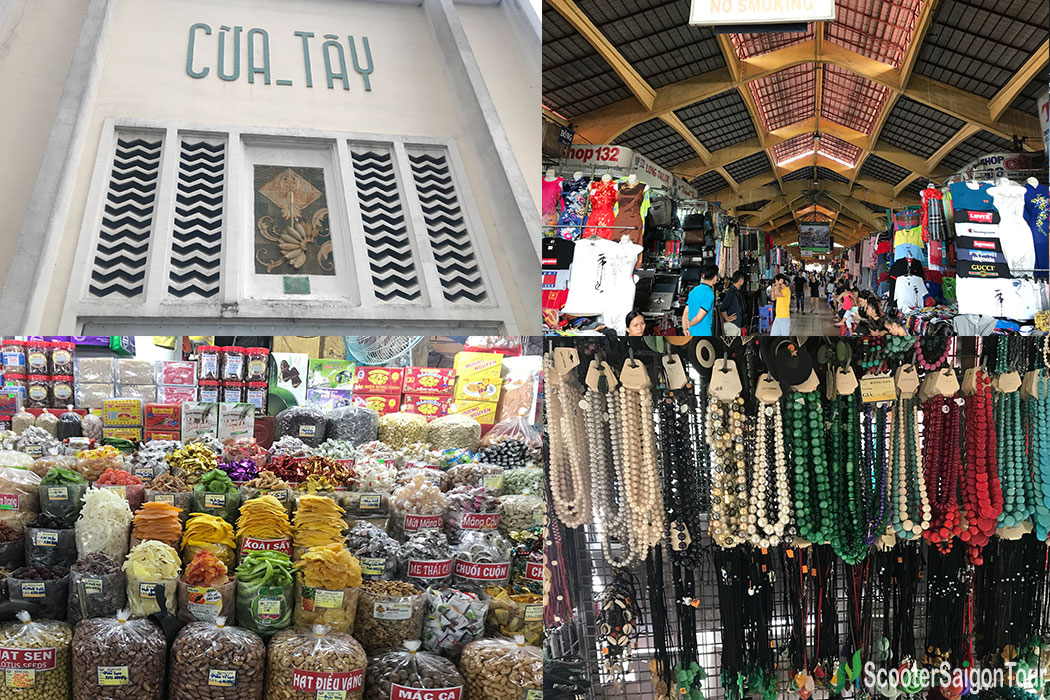
There are thousands of cheap and high-quality things to buy at Ben Thanh Market in Ho Chi Minh City.
91. Shopping traps
Some coffee and tea shops, painting galleries, specialty food stores and souvenir shops pay tour guides and drivers 30% bills. Prices at these places are very high. Sometimes, you are forced to these shopping places on a group tour. Do not buy anything before researching prices and the best places to buy. Choosing reliable tour operators is important because professional and good tour guides do not recommend you to buy overpriced items on tours.
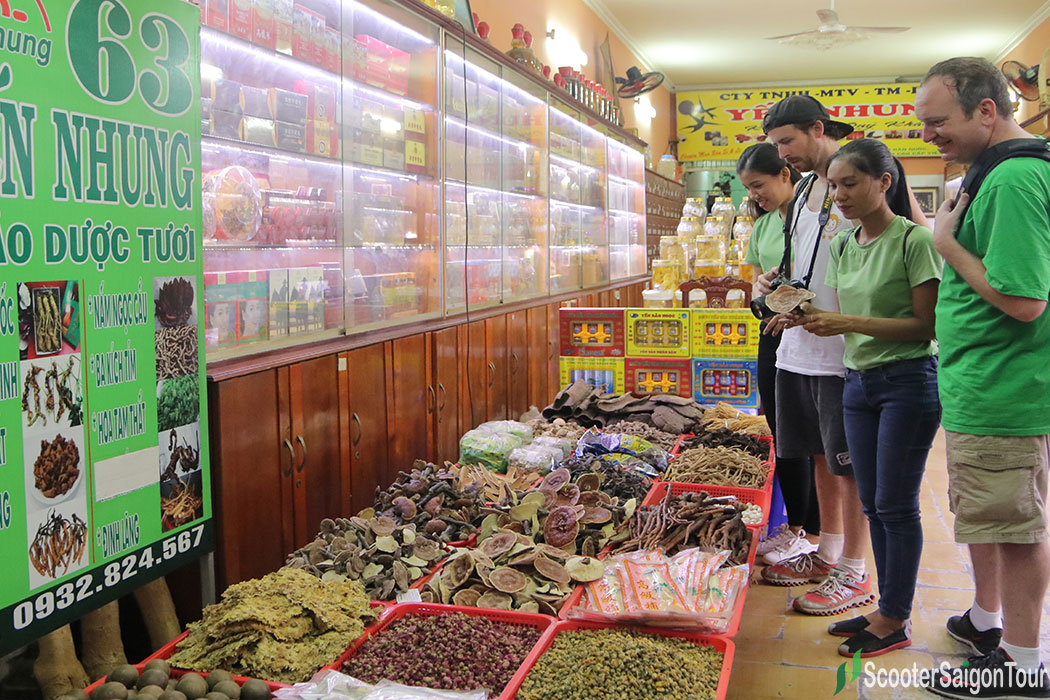
Choose good tour companies to avoid tourist traps.
Bargain in Vietnam
92. Haggling at local markets, shopping centers or shops in Vietnam is a must. Although they sometimes say or write prices are fixed, sellers may agree to sell their products at lower prices. Surprisingly, you can offer less than 50% of the asking price, then gradually move up to about 40-50% of the asking price. You can leave your offer is not accepted. The seller may call you back or let you go. Before haggling for anything, see how other people haggle and how much they pay for the item you would like to buy. Do not let them know that you really want the item.
Buy tailored clothes
93. You will be satisfied to buy your tailored clothes in Vietnam where there are lots of talented tailors. Just choose fabrics and styles, you can show them your catalogs, pay the deposits and have your clothes finish from 24 hours to 3 days. You can buy the best tailored Ao Dai, suits, shirts, blouses, dresses and skirts in Hanoi, Ho Chi Minh City, Hoi An.
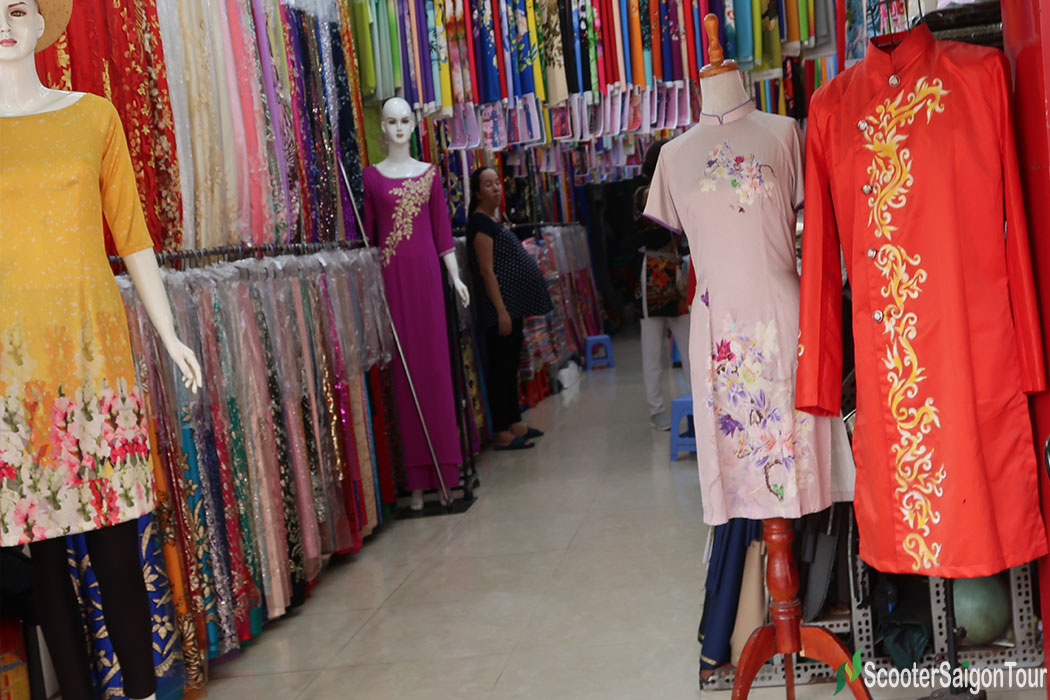
An Ao Dai tailor shop in Ho Chi Minh City.
Haircut, massages are relatively cheap
94. Do not have your hair cut, colored and highlighted before going to Vietnam because these services are cheap in Vietnam and you will be satisfied with the results you get. Prices of hair cuts in Vietnam are from $2 USD to $8 USD.
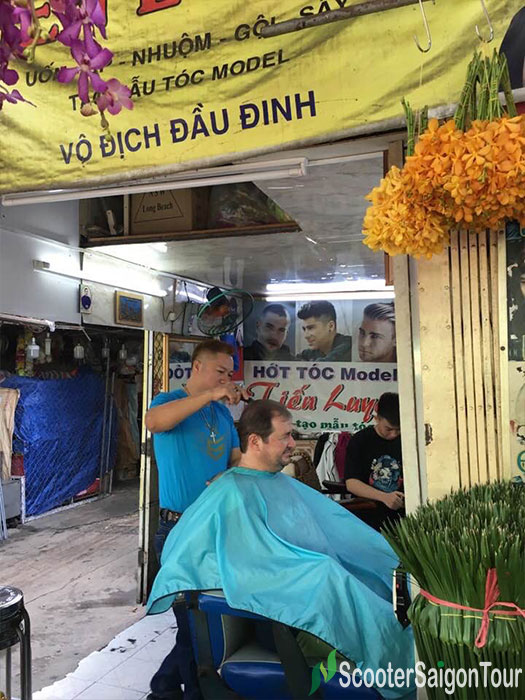
A foreigner has his hair cut at a barber shop in Ho Thi Ky flower market.
Tipping
95. Tipping is not a must in Vietnam. We do not tip workers at laundromats, tour sales, sellers at shops and local markets. You can tip waiters, tour guides, barbers, hairstylists, masseurs, receptionists, bell boys if you are satisfied with the services. At some restaurants, all tips are collected and shared to all workers including chefs, chef attendants, bartenders, cleaners and other waiters. At other restaurants, the waiter can keep the money he is tipped. Some people tell the workers to keep the changes as tips. You can tip as much as you want in Vietnam and all the workers are happy with that. I would like to recommend the tips as follows:
- Tour guide: from $5 USD/day; Driver: $3-5 USD/day;
- Cyclo rider/boat rider: from $2 USD/hour; Horse cart driver: from $0.5 USD/15-minute ride.
- Taxi driver/motorcycle taxi driver: $0.5-3 USD.
- Bell boy and housekeeper at hotel: $1-2 USD;
- Receptionist: from $2 USD;
- At a restaurant: $1-3 USD;
- At a spa: 15-20% bill.
- At barbershop or hair salon: from $2 USD.
Read more about The ultimate guide to tipping in Vietnam
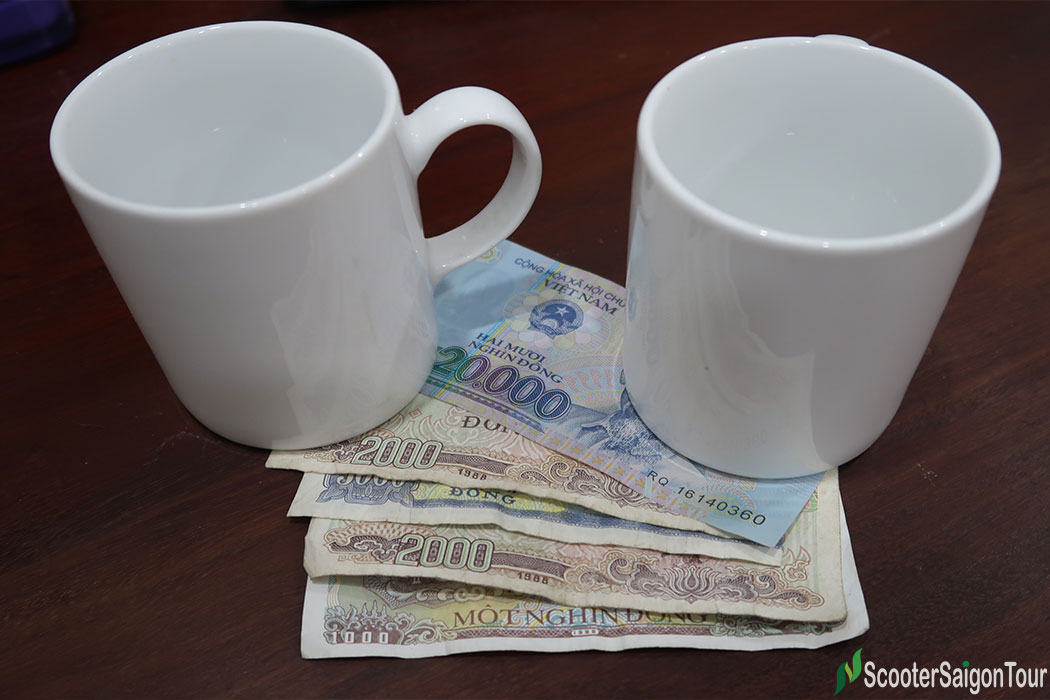
Leave your tips on dining tables or hand the money to waiters.
Language
96. A large number of Vietnamese people speak limited English except for tour guides and people working in tourism industry, some students, English teachers and officers, doctors at international hospitals. At some famous markets which are top tourist attractions, vendors speak a little English. So that some popular Vietnamese phrases are helpful in your trip:
Hello: Xin chào;
Goodbye: Tạm biệt;
Thank you: Cảm ơn;
Sorry: Xin lỗi;
How much?: Bao nhiêu?;
How are you?: Bạn khỏe không?
No problem: Không có gì
What is your name?: Bạn tên gì?
My name is …: Tôi tên là …
Can you speak English? Bạn có thể nói tiếng anh được không?
Too expensive: Mắc/Đắt quá
I would like to offer …: Tôi đề nghị
One size larger: một size lớn hơn
One size smaller: một size nhỏ hơn
Read more about the most common Vietnamese phrases, words, numbers at shopping places, restaurants, emergency rooms.
Bringing a small Vietnamese common phrase book or an English – Vietnamese dictionary is recommended. In recent, many travelers install translator apps and dictionary apps on their smartphone and they do not need to bring any book or dictionary.
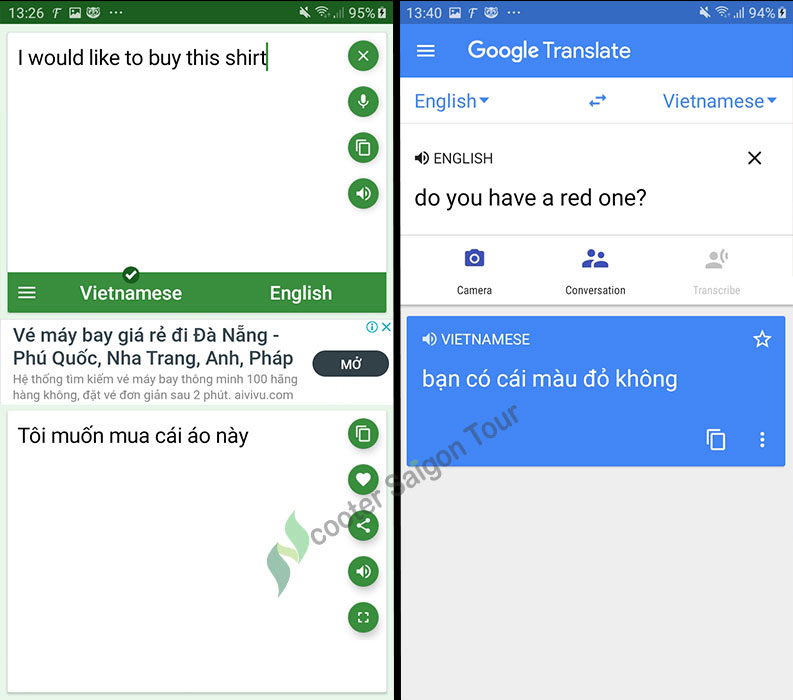
Screenshots of English – Vietnamese Translator (left) and Google Translate (right) apps on smartphone.
Things to know before booking tours
97. Package tour or travel on your own? This is one of the most frequent questions of travelers who plan their trip to Vietnam. As I see, the elderly and middle-aged usually book package tours, young people would like to challenge themselves by booking flights, trains, buses, hotels, tours, other services with different tour agencies including online travel agents. People who travel on their own can customize their trips and have chances to explore the country better. However, there are lots of risks that people booking package tours stay away from.
98. Booking tours and services on OTAs or directly with tour operators or hotels? Just compare the prices provided by OTAs and prices provided by tour operators or hotels.
99. Student tour is a good choice to maximize your budget and interact with local people. Your student guide can be good or not good enough, can speak English fluently or speak a little English, can give you necessary or a little information about the attractions. However, they will show you the real things about Vietnam, which well-trained and experienced tour guide hide from you. Some student tours are free, some cost about $10 USD. You should tip the local students $2-8 USD if you are happy with the tours.
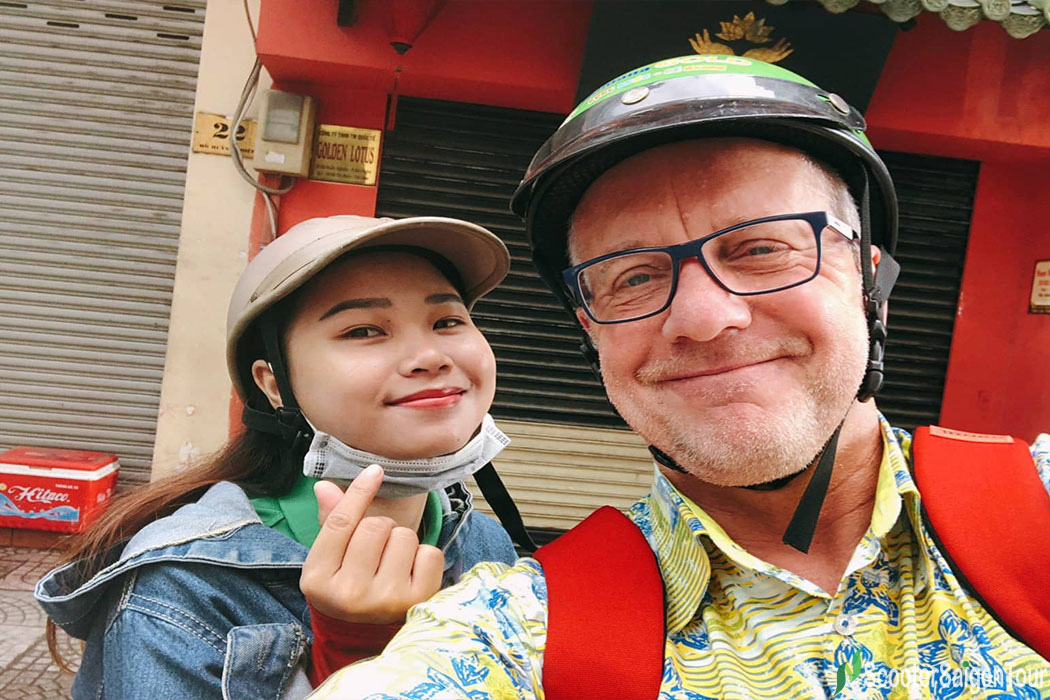
Tours with local students are worth-trying experiences.
Safety and security
There may be an increased police presence station in Cư Kuin District in Dak Lak Province and the surrounding areas after a recent attack by an armed group on a police station. There is no reason to believe that there is any heightened risk for tourists. Remain vigilant and follow the direction of local authorities.
Crime
Most visits to Vietnam are trouble free but you should take sensible precautions to protect yourself and your belongings in big cities and tourist areas.
Don’t hand over your passport to third parties as a guarantee (e.g. to motorcycle rental shops, landlords) as there have been many instances of companies holding on to passports against claimed damage.
You should remain alert and take care of your belongings, particularly in crowded areas and places visited by tourists where pick pockets and bag snatchers operate, including on motorbikes. Consider splitting key items between bags.
British nationals have reported a number of personal attacks, including rape and sexual assault in areas popular with expatriates and tourists. When reporting such attacks in Vietnam, compared to the UK there is a high burden of proof on the victim to demonstrate that the sexual relations were not consensual, especially when the victim had consumed alcohol or where the alleged attacker was known to the victim.
There have also been some reports of foreign women being victims of indecent assault and harassment (including inappropriate touching and groping), particularly while walking alone. You should take sensible precautions.
There have been reports of arguments over hotel, restaurant or taxi bills turning violent or abusive. It is well worth researching places to stay before you arrive. To avoid potential disputes, make sure you are clear about the level of service you can expect to receive and any associated charges.
Local travel
A number of British and foreign visitors have died or been injured in Vietnam while engaged in adventure tourism in rural and mountainous areas. Some terrain can be hazardous and remote from rescue services of any kind. And the rainy season – see Natural Disasters – can quickly and significantly increase risk, especially for localised flooding, navigating swollen streams and rivers and landslides.
Safety standards are generally lower than in the UK and compliance varies. Don’t stray off main routes and, where required, take a reputable guide. Always follow safety guidelines, check local authorities’ websites for adventure tourism companies that are approved and meet safety standards and check local weather forecasts before travelling.
You should avoid illegal tour guides who have been known to offer tours and activities prohibited under local regulations. In some areas local regulations require the use of a guide. Make sure your travel insurance covers your planned activity fully.
Travel is restricted near military installations and some areas of Vietnam are fairly inaccessible. If you wish to visit a village, commune or ward that is close to the border you may need to get permission from the provincial police department. Contact the relevant local authority for more information.
Unexploded mines and ordnance are a continuing hazard in former battlefields, particularly in central Vietnam and along the Laos Border, formerly traversed by the Ho Chi Minh Trail. Mined areas are often unmarked.
Undertake any leisure activities that include firearms at your own risk and make sure you are supervised by a reputable guide. There have been reports of hearing loss from those close to these activities.
Road travel
Travelling by motorbikes in Vietnam carries significant risk. There are frequent road traffic accidents and fatal crashes. According to World Health Organisation statistics, you are over 8 times more likely to be killed in a road traffic accident in Vietnam than in the UK (an estimated 26.4 deaths per 100,000 people in Vietnam compared to 3.1 per 100,000 people in the UK).
A number of British nationals have died in motorbike accidents in Vietnam, and many more have been involved in accidents, with some injured very seriously. Before choosing to drive a motorbike in Vietnam, it is essential that you’re an experienced motorbike rider, check your motorbike thoroughly and rent from a reputable organisation, have a good quality motorbike helmet, understand the roads on which you plan to travel and that your travel insurance covers your planned activity.
Compliance with local road regulations is poor. You’re advised to keep your speed down and to be prepared for the unexpected. If you’re planning on travelling as a passenger on a motorbike, you should wear a good quality helmet and make sure your medical insurance is comprehensive. It’s illegal to be on a motorbike without a helmet.
If you’re involved in a traffic accident, you could face criminal charges and you may need to pay compensation to the injured person even if the injuries are minor. If you’re involved in an accident or subject to an investigation, offer the police your full co-operation and inform the British Embassy in Hanoi or Consulate General in Ho Chi Minh City.
If you wish to drive cars or ride motorbikes in Vietnam you will need to present your UK driving licence and a UK-issued International Driving Permit (IDP). If you’re a long term resident in Vietnam, you can qualify for a Vietnamese driving licence with a diplomatic ID, temporary residence card or residence card validity for 3 months or more and also a valid UK driving licence or UK-issued IDP. Applications for a Vietnamese driving licence can be made at the local offices of the Department of Public Works and Transportation.
You should also make sure you have third-party insurance as required by Vietnamese law.
Don’t use your passport as a deposit for hiring vehicles or in place of a fine in the event of a traffic offence.
Metered taxis from larger firms are generally reliable. There are many taxi operators and meters are set at different prices. The meter should start at around 8,000 to 20,000 VND, depending on the size of the taxi and the taxi company. Where possible get hotels or restaurants to book you a reputable taxi. Always make sure the driver identifies themselves before setting off. If you book a taxi online or through an app, make sure the details of the vehicle and driver match those provided by the company.
Overcharging for taxi journeys in and around the tourist hotspots in the Old Quarter of Hanoi and at Hanoi Airport is regularly reported. The same occurs at Ho Chi Minh City’s airport and popular tourist attractions. Check the published fares near the taxi stands or an online app before starting your journey or consider booking a taxi or ordering one via an online app.
Bus and coach crashes are not unusual and increase in regularity at night. Vehicles are often poorly maintained. When travelling by bus, be vigilant against petty theft as there have been reported cases of people losing passports and personal belongings while travelling on night buses. Be cautious about offers of free transfers to hotels unless organised in advance, as these may be bogus.
Driving cars or riding motorcycles when your blood alcohol concentration is more than zero is illegal. This is enforced rigorously.
Rail travel
Rail travel in Vietnam is generally reliable. Be aware of the risks of petty theft, particularly while asleep on overnight trains.
Sea travel
Safety regulations and standards vary greatly and are not at the same level as the United Kingdom. Check with your tour guide about the safety record and registration of boats, and the certification of personnel before setting off. Make sure you receive a full safety briefing when joining any boat. Consider safety standards carefully before taking an overnight boat trip on Halong Bay as some boats have sunk quickly and without warning.
Piracy in coastal areas off Vietnam is very rare. Mariners should, however, report all incidents to the coastal and flag state authorities.
Political situation
Vietnam has a single party political system, which does not welcome dissent. Some protests in recent years have turned violent, or been violently suppressed by the authorities. You should avoid all protests.
Consular assistance
Providing prompt consular assistance can be difficult outside Hanoi and Ho Chi Minh City. Vietnam is a large country and some areas don’t have well developed infrastructure or frequent flights.
How to Be a Non-Touristy Tourist in Vietnam
Each year upwards of fifteen million people visit Vietnam. It is no wonder that with its diverse natural beauty, unique culture, delicious food, and more, that Vietnam is a popular tourist destination. But, sometimes, being thrust in with throngs of other tourists can hamper your ability to experience authentic Vietnam.
If you are looking for things to do that are unique to Vietnam, then why not explore the lesser-known, hidden gems? By stepping off the proverbial beaten path, you can take in the majestic beauty of Vietnam, experience the traditional Vietnamese culture, and avoid the crowds.
15 of the Best Places to Visit in Vietnam
Here are fifteen of the lesser-known places you will find when you step off that beaten path. While many of the locations may be more remote, you might be surprised at the accessibility of these Vietnam travel spots.
1. Cham Islands, Part of Cu Lao Cham Marine Park
If you love the tranquility of a tropical island but want an alternative to tourist traps like Hawaii’s Waikiki, try the Cham Islands. Vietnam’s Cham Islands are located near the town of Hoi An on the coast of the South China Sea. The Cham Island chain can be reached via an hour-long boat trip.
Recognized by UNESCO as a World Biosphere Reserve, the Cham Islands are part of the Cu Lao Cham Marine Park and consist of eight small islands. A natural coral reef provides the perfect spot for exploring underwater wonders via snorkeling and scuba diving.
2. Bai Tu Long Bay, the Northeast Portion of Halong Bay
The world-famous Halong Bay is certainly still a treat when visiting Vietnam, but it can be busy. If you want to avoid crowds and experience a quieter, more serene Vietnam, Bai Tu Long is the place to visit. Filled with clean and often deserted beaches, Bai Tu Long Bay spans 100km and travels up to meet the border to China. With beautiful limestone karst mountains covered in green and breathtaking water views, Bai Tu Long will not disappoint.
3. Co To Island in the Gulf of Tonkin
Co To Island is actually an archipelago, or a group of many small islands – the main island being Co To Island, along with the smaller Co islands, Thanh Lam island, and many more. Located off North Vietnam near Van Don Station and Quang Ninh Province, Co To Island features soft white sand that contrasts with the aquamarine ocean waves. With its quaint fishing village, lighthouses, and forests, there is plenty to explore.
4. Con Dao Island, the Mysterious Island
Con Dao Island is a true hidden gem. Con Dao National Park makes it an amazing place to experience local wildlife. Other popular activities include exploring coral reefs and fishing. Unfortunately, the secret may be out: In 2011, Con Dao was named by Lonely Planet as one of the “Top 10 Mysterious Islands.”
5. Nam Du Islands, Part of Kien Giang Province
Another stunning archipelago to visit in Vietnam is the Nam Du Islands, located 60km from the Vietnamese mainland. While these twenty-one islands may not boast tons of white sandy beaches, they are still some of the most breathtaking beaches you will ever see. Offering stunning panoramic views, the Nam Du archipelago is often called the “mini Halong Bay.”
6. Ly Son Island, Quang Ngai
Needing your fill of fresh Vietnamese seafood? Try Ly Son Island! Found in Northeast Vietnam, Ly Son is the only island district in Quang Ngai. Seafood, seaweed delicacies, Vietnamese garlic salad, and even salted anchovies are just a few of the island’s fare you can experience during your visit.
7. Bình Ba Island, Cam Ranh Bay
Located in Cam Ranh Bay, a mere 20km from mainland Vietnam, is Bình Ba Island. Known as “Lobster Island,” this is another wonderful place to visit if you love seafood. The lobster here is not only affordable but plentiful and considered to be the best in all of Vietnam. Bình Ba Island is an interesting place to tour for its historical significance. Spend time exploring bunkers, cannons, and even a tunnel built into a mountain, all relics of the French colonial era of the 1940s.
8. Pleiku – The “Best Sleeping City” of Vietnam
If you are looking for an urban experience in Vietnam without all the stress, try Pleiku, also known as the “best sleeping city” of Vietnam. With a population of around 450,000, Pleiku offers shopping, restaurants, and attractions. Located in a valley in central Vietnam, Pleiku’s beautiful scenery and plentiful opportunities for nature hikes are a must-see.
9. Kon Tum, Connecting to Laos and Cambodia
If you would like to experience Vietnam’s nature beyond the beaches, visit the Kon Tum province. Located in the Central Highlands, Kon Tum is a true representation of rural Vietnam. Connecting with the countries of Laos and Cambodia (the Indochina Fork), the Kon Tum province has many natural wonders. To the north, you can see the highest granite mountain range found in southern Vietnam. Beautiful forests and rivers play host to exotic wildlife and rare birds. Kon Tum is also known for its red basalt soil. Other notable places are the Dak To Hot Spring, Kon Tum Museum, Wooden Church, and the Ho Chi Minh Trail.
10. Trang An Grottoes
The Trang An Grottoes are a series of caves and waterways that are accessible by a small boat. Located in Ninh Binh province, Trang An is close to the ancient Vietnamese capital of Hoa Lu. More visitors tend to visit the caves nearby in Tam Coc, but because of this, hawkers and vendors often bog down the experience. For this reason, some travelers prefer Trang An, which is quieter, less commercial, and just as beautiful.
11. Ban Gioc Waterfall, Cao Bang
While famous amongst locals in the Cao Bang province, the Ban Gioc Waterfall is not a typical spot for international tourists. This stunning waterfall, backed by limestone hills, makes it a must-see. Nearby, the fantastic Nguom Ngao cave features a fascinating collection of stalagmites and stalactites.
12. Pu Luong Nature Reserve
The name “Pu Luong” is Thai for “highest mountain.” Four hours southwest of Hanoi, the Pu Luong Nature Reserve is a wonderful place for ecotourism. This amazing area boasts quaint villages nestled among forests, rice paddy terraces, abundant bamboo, and Vietnam’s unique mountain landscape.
13. Ha Giang Province
For people who love mountains, Ha Giang Province should be on their list. Located in the Vietnamese northwest highlands, Ha Giang is a place with meandering roads that wind through rocky, green-covered mountains and serene valleys. Filled with traditional Vietnamese terraces, Ha Giang is also a producer of buckwheat. Noteworthy places to visit include the Dong Van rock plateau (recognized by UNESCO), the mansion of the Vuong family, the majestic Lung Cu flag tower (Vietnam’s “North Pole”), and the “Happy Road.” The Ha Giang Loop, also known as the Happiness Road, is breathtaking! The best way to experience it is to take a three-day motorcycle trip.
14. Ba Be Lake, Bac Kan Province
Ba Be Lake is an exceptional freshwater lake. It was formed by geological changes millions of years ago. These geological events also created stunning limestone mountains and karsts, along with mesmerizing caves. Imagine boating or kayaking through a watery wonderland surrounded by mystical mountains and green jungles.
15. Dien Bien Phu, More Than Just a Battlefield
The Dien Bien Phu province in Northwest Vietnam is well-known for being the location of “The Battle of Dien Bien Phu,” fought between the French and the Viet Minh communist revolutionaries in 1954. This battle is considered a major turning point in the war, vital to the defeat of the French. For those interested in history, relics from the battle can still be seen.
Dien Bien Phu is a fitting example of Vietnam’s diverse natural bounty. Beautiful mountains, lush forests, and winding rivers are all there, with many lakes and caves to explore. You can also visit a 150km rice paddy field in Muong Thanh valley.
